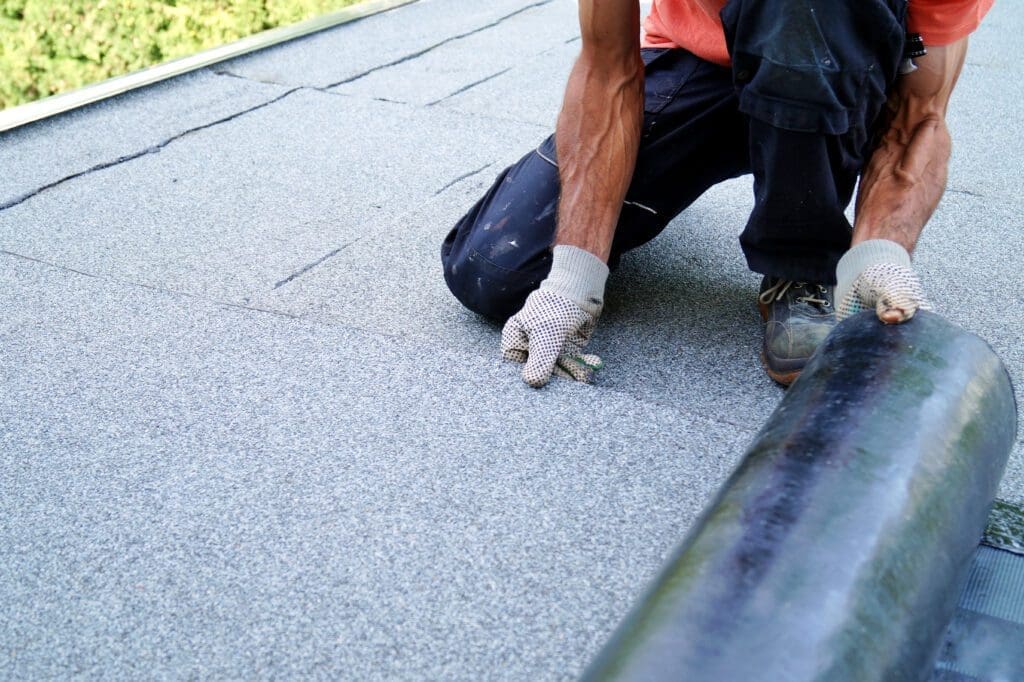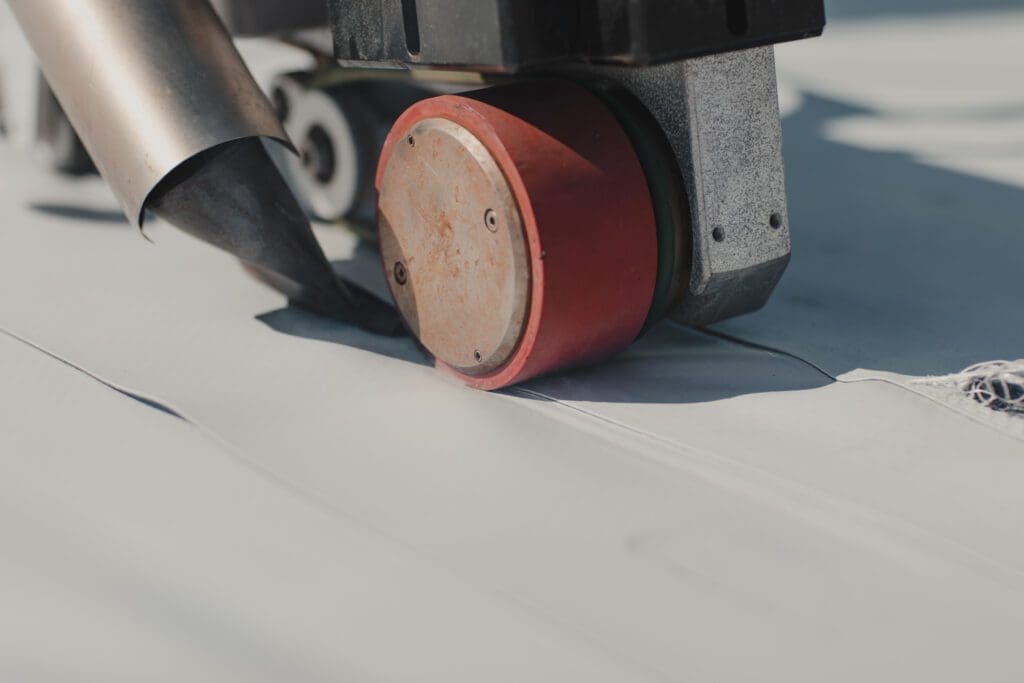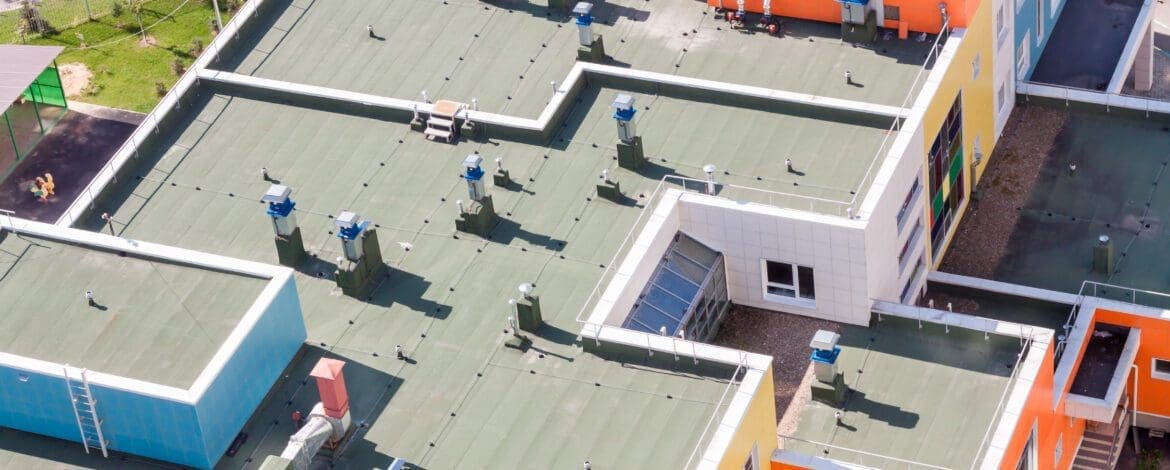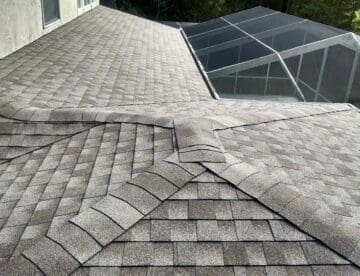If your home has a low-slope, or “flat” roof, you have a few options to choose from when it’s time to re-roof. You can read about many of those options in this post. In residential applications, few roofs are truly flat, and are actually a low-slope roof, with a pitch of 3:12 or less. Here we’ll compare two of the most popular roofing systems for low-slope roofs: TPO vs modified bitumen roofs.
Though they both are used on low-slope roofs, these two roofing methods are quite different from each other. TPO is a membrane roof, which is basically a big roll of synthetic material made in a factory. It’s similar to the other commonly used membranes, EPDM and PVC. We’ll get into more detail in a moment.
A modified bitumen roof is an update of one of the older roofing methods, the built-up roof, or BUR. A BUR is often called a “tar and gravel” roof, as it uses low-tech but relatively durable materials. Layers of roofing felt are slathered with hot tar, layer after layer, and then topped with gravel. All those layers make for a relatively durable roof, but it’s a slow, messy, and smelly process. All those material make for a heavy roof, too.
Why to Choose a Modified Bitumen Roof
To address some of the drawbacks of a BUR, namely the overall weight, as well as the slow and smelly installation process, roofers in the 1970s developed the modified bitumen roof. It’s more similar than different, but the major difference is a big one: a synthetic cap sheet that replaces the gravel layer.

Why is this important? First, the cap sheet is much lighter than a layer of stone. The cap sheet usually comes with a granular layer, which can be a relatively light color. That’s good for energy efficiency compared to any dark-colored roof.
The asphalt mix in a modified bitumen roof is actually a cocktail of additives along with the asphalt. Those additives enhance the material’s flexibility and help it to withstand the sun’s UV radiation. They also help a modified bitumen roof last up to 20 years, which is pretty good for a flat roof.
Cons of a modified bitumen roof are the number of seams. The rolled material comes in 3′ widths, so the roof will have more seams than a membrane roof. This type of roof also does not endure ponding water well, so if your roof is truly flat, or has low spots that collect water, that’s a problem. A competent roofer will point this problem out to you, but the fix may be tough. The rafters could be sagging, for example. Are you prepared to make that repair when you thought you were just getting a roof replacement?
As for cost, this is a labor-intensive roof type but overall cost is midrange. You can figure on paying $7.50 to $13.50 per square foot installed, depending on the condition of the existing roof, your home’s location, and so on. Also check out this site for more cost information.
Why to Choose a TPO ROOF
TPO is short for thermoplastic polyolefin. This roofing type came to market in the 1990s and it didn’t go all that well at the start. Manufacturers did not have their processes sorted out, and some sub-standard material was sold and installed. To this day, some roofers still believe that TPO is a shoddy material, but it’s now completely unfounded. We use one of the top manufacturers of TPO in the world and the quality control is impeccable. If you hear anyone slamming TPO today they are misinformed.
We install quite a few TPO roofs. In fact, our commercial division installs more TPO roofs than any other installer in the state of Florida. Why are we all-in on TPO? Here are several reasons:
- Moderate cost: overall, this type of roof is budget friendly for most homeowners.
- Great durability: we expect a TPO roof that we install to last around 25 years.
- Great energy efficiency due to the light color: this can’t be overstated in sunny Florida, as the sun’s rays are intense and heat up a dark-colored material to over 200°.
- Fast installation speed: with rolls available in multiple widths’ such as 6′, 8′, and even 12′, TPO covers a roof quickly.
- Withstands ponding water.
- Light weight: compared to a multi-layer BUR or modified bitumen roof, a layer of insulation covered with a TPO membrane is very light in weight.
- Withstands foot traffic.
- Can be installed over other roof types: this is dependent on the condition of the existing roof, but TPO can be installed over metal and modified bitumen roofs under certain conditions. That saves you the cost and mess of tear off.
Compared to other membranes, TPO comes out on top for durability and mid-range for cost. A professionally installed TPO roof should last 20-25 years. An EPDM roof, in comparison, will be cheaper but won’t last nearly as long. A 10-15 year roof does not seem like a great value. A PVC roof is a very solid and dependable membrane but will cost more without delivering a substantial increase in life.

One other important factor is the seams: TPO seams are welded and can be re-welded in years ahead as necessary. EPDM, in comparison, uses an adhesive that can fail over time. Lastly, the TPO membrane is fully recyclable. This may not seem too important right now, but who knows what disposal costs will be in 25 years? You won’t have that issue with a TPO membrane.
Cost for a TPO roof should be in the range of $8.50 to $14.50 per square foot installed. Of course, your location, your home’s construction, need for repairs, and so on will also matter, but that’s a rough guide. Also check out this site for more cost information.
We’re Here When You Need Us
If you’d like to talk about replacing your low-slope roof, give us a call at 813-373-9088. Our team has more than 40 years of experience in roofing. You can also use this form and ask us, “what’s the cost to replace my roof?” and we will contact you.



